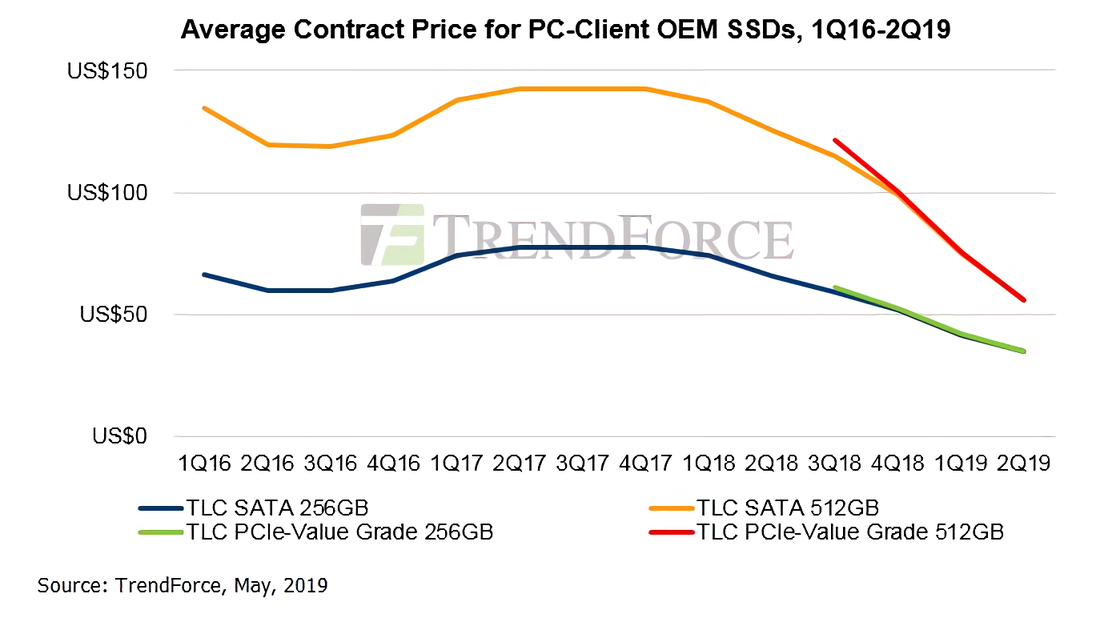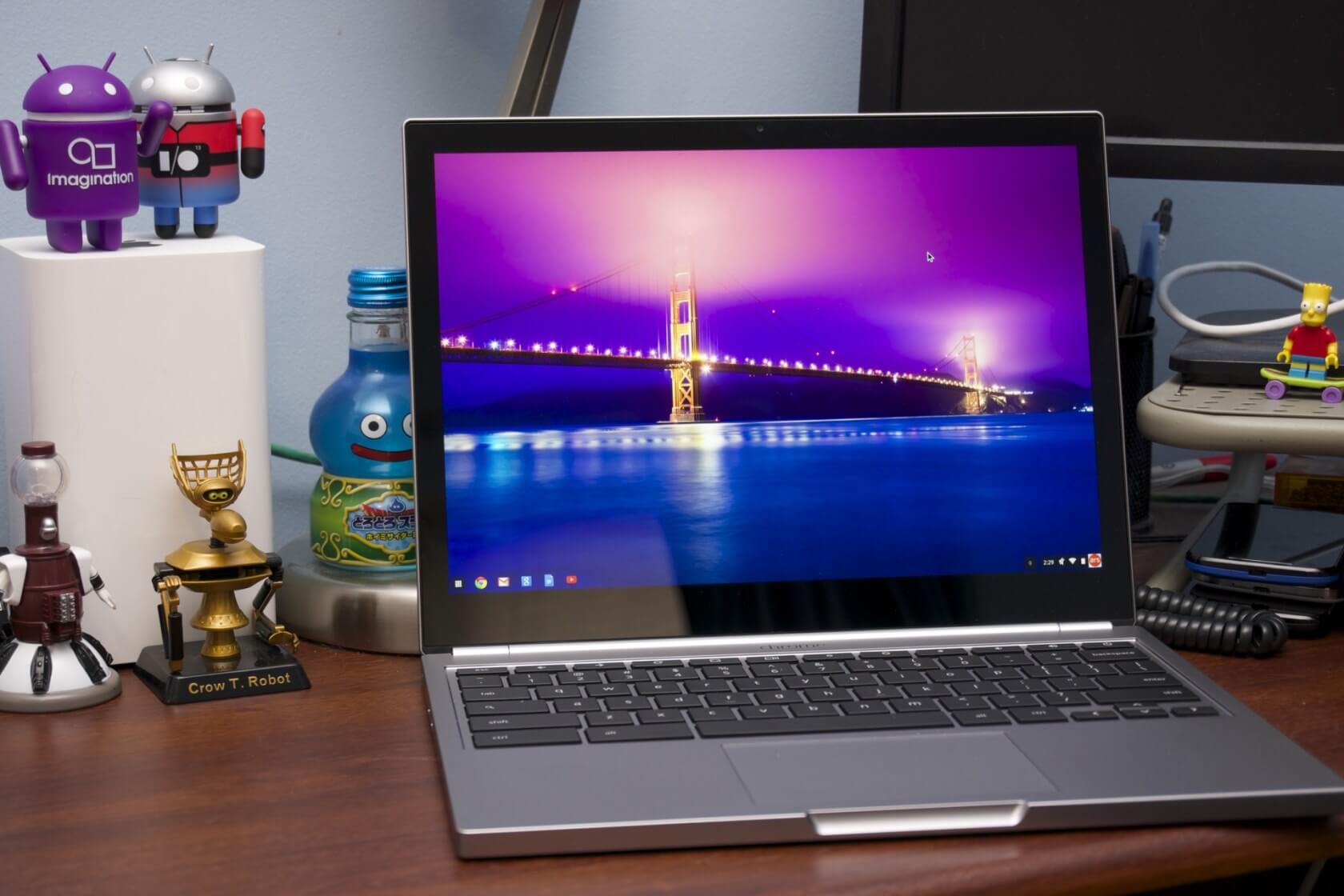SSDs on pace to reach lowest price-per-GB ever by year’s end
The big picture: Continued oversupply in the NAND flash space is pushing suppliers into a price war, resulting in some of the lowest SSD prices we’ve ever seen. By the end of the year, SSD prices per gigabyte could dip below $0.10 for the first time ever. Time to upgrade your storage?
DRAMeXchange, a division of market intelligence firm TrendForce, said this week that the NAND flash industry is clearly exhibiting signs of oversupply which has lured suppliers into a price war. As such, SSD prices for PC OEMs have dipped dramatically and for the first time ever, contract prices for 512GB and 1TB have a chance to creep below $0.10 per gigabyte by the end of the year.
DRAMeXchange said market conditions will cause 512GB SSDs to replace their 128GB counterparts as mainstream offerings alongside 256GB SSDs. The firm also expects PCIe SSDs to reach 50 percent market penetration as they are nearly identical in price to SATA SSDs. General SSD adoption rates could reach 65 percent this year.

This isn’t exactly a new trend, either. Q2 will mark the sixth consecutive quarter of contract price declines for mainstream PC-Client OEM SSDs.
Reasons for the continued freefall in pricing are aplenty, as DRAMeXchange highlights.
Weakened stocking momentum due to the cautious stance of PC, smartphones and servers/datacenters OEMs towards end market sales and high inventory levels, leading to an overly oversupplied NAND flash market; price wars by leading SSD suppliers who are keen to get their 64/72-layer stocks off their hands; and the price comparison effect as a result of Intel 3D QLC SSDs.
The impact of Intel’s ongoing CPU supply shortage is also a major factor in the overall equation although with the back-to-school season and the holidays not too far off in the distance, stocking demand is expected to improve.
Lead image courtesy SvedOliver via Shutterstock
By: Techspot
Mozilla could be planning to roll out a ‘Super Private Browsing’ mode for Firefox
Privacy: Despite their immense popularity, the “Private” or “Incognito” modes you see in many modern browsers aren’t really as private as they appear. In many cases, they do little more than prevent your search history, cookies, and passwords from being recorded locally. There are a few exceptions to this (Firefox’s Private Browsing feature also has “Content Blocking” tracking protection), but for the most part, people tend to vastly overestimate the protections these modes offer.
To address this, Firefox may be planning to roll out a “Super Private Browsing” (SPB) mode that could provide users with true anonymity; or at least as close to true anonymity as you can get with a normal browser.
This news comes via PC Gamer, which spotted an interesting piece of information within Mozilla’s 2019H1 Research Grant program. In this program, Mozilla is looking to offer funding to those who can answer one (or more) of 12 questions related to the future of Firefox and web browsing as a whole.
The 12th main question (RQ12), which covers “Privacy & Security for Firefox,” is where Mozilla first mentions its interest in providing an SPB mode to its users. This mode, according to Mozilla, would integrate Tor into Firefox to block “mass surveillance, tracking, and fingerprinting.” However, the organization recognizes that doing so wouldn’t be easy.
“…enabling a large number of additional users to make use of the Tor network requires solving for inefficiencies currently present in Tor so as to make the protocol optimal to deploy at scale,” Mozilla states. That’s where you — or, more specifically, any privacy researchers who may happen to be reading this — come in.
If Mozilla can answer the following questions, there’s a good chance SPB could become a reality:
- What alternative protocol architectures and route selection protocols would offer acceptable gains in Tor performance?
- And would they preserve Tor properties?
- Is it truly possible to deploy Tor at scale?
- And what would the full integration of Tor and Firefox look like?
By: Techspot
Every Chromebook launched in 2019 will run Linux ‘right out of the box’
Linux is a fantastic operating system, and as a result, it’s the go-to choice for many power users or those who simply don’t care for Windows 10. Given some of the major issues Microsoft’s latest OS has — such as the infamous file-deletion bug of 2018 — that’s perhaps an understandable viewpoint.
Google is clearly a big fan of Linux, too. Throughout 2018, the search giant harnessed the power of virtual machines to enable Linux app support on select Chromebook devices, such as Samsung’s Chromebook Plus. Chromebooks, for the unaware, are stripped-down notebooks that exclusively run apps downloaded from the Chrome Web Store (with a few exceptions).
At any rate, opening up the experience with Linux app compatibility was a pretty major boon for anyone who happened to own a compatible device. For those individuals, what were once niche school or web browsing devices turned into much more practical laptops; albeit with weaker hardware.

There’s more good news now, too. Google announced at its annual I/O developer conference that “all [Chromebook] devices launched this year will be Linux-ready right out of the box.” That means that the laptops will be able to run full distributions of Linux with no (or minimal) hardware or software hacking necessary.
In the case of Debian Linux, as ZDNet points out, running it is as simple as typing “Terminal” into Chrome OS’ Search tool. Running other distributions of the open-source OS is a bit more complicated, but the process is still easier and more secure than it’s ever been.
We’ll keep you updated when the first Linux-ready Chromebooks hit the market this year. Until then, feel free to check out our guide dedicated to running Linux in the background on Chromebooks – the process is much smoother and faster than you might think.
By: Techspot
Skullcandy launches the ‘Indy’ earbuds, an $80 alternative to Apple’s AirPods
Apple’s AirPods are one of the best-selling wireless earbud devices on the market, and for good reason – the audio quality is solid, they’re easy to use (there’s no wires connecting one bud to the other), and they tend to last for quite a while, assuming they don’t get damaged by the user.
The AirPods’ success has led many of Apple’s competitors to follow in its footsteps, coming up with their own wireless earbud alternatives. Samsung’s Galaxy Buds are one example and Microsoft is reportedly working on Surface-branded earbuds of its own.
Unfortunately, while the Galaxy Buds are cheaper than the AirPods (which cost $199), they’re still decidedly high-end at $129.99. We don’t know how much Microsoft’s buds will cost, but we don’t expect them to be much more affordable than either of these offerings.

However, for those who want a truly wireless earbud experience but can’t afford either of the previously-mentioned options, there’s good news now: audio device maker Skullcandy has revealed its “Indy” earbuds, and they seem perfect for budget-conscious users. The Indy buds more closely resemble the AirPods than the Galaxy Buds, due to their dangling antennas – which could prove to be a somewhat polarizing design decision among Skullcandy faithfuls.
Regardless, the Indy’s low price tag may just make up for its potentially-controversial aesthetic: it will run you just $79.99, which is less than half the price of Apple’s popular alternative. The Indy also ships with its own charging case, the promise of “up to” 16 hours of battery life, and IP55 sweat, water, and dust resistance).
If the Indy buds sound like your cup of tea, you can snag them now from Skullcandy’s official website.
By: Techspot
Intel to ship Ice Lake in June, launch first 7-nanometer parts in 2021
Forward-looking: Intel has been stuck on the 14-nanometer process for far longer than it likely ever envisioned but fortunately for all parties involved, that should be changing soon. Chipzilla will soon be shipping 10-nanometer Ice Lake parts as it eyes an eventual move to 7-nanometer in 2021.
Intel at its 2019 investor meeting this week said it will begin shipping its first volume 10-nanometer processor, codenamed Ice Lake, in June. As previously announced, Intel expects the first Ice Lake-based devices to be available to consumers in time for the 2019 holiday season.
Chipzilla said it expects the Ice Lake platform to deliver 3x faster wireless speeds, 2.5 to 3x faster artificial intelligence performance, 2x faster video transcode speeds and 2x faster graphics performance compared to previous generation products.
Multiple 10-nanometer products are expected to launch through 2019 and 2020, Intel said, including the Snow Ridge SoC, a general-purpose GPU and additional CPUs for clients and servers.

Gazing further down the road, Intel said its first 7-nanometer product – an Intel Xe architecture-based, general-purpose GPU for data center AI and high-performance computing – will launch in 2021. The GPU will reportedly deliver 2x scaling and provide a 20 percent increase in performance per watt with a 4x reduction in design rule complexity.
It’ll also mark Intel’s first commercial use of extreme ultraviolet (EUV) lithography which the company said will drive scaling for multiple node generations to come.
By: Techspot
Amazon says hackers were able to steal funds from seller accounts last year
The big picture: Amazon believes it fell victim to an “extensive” fraud against many seller accounts. Hackers were able to gain access to about 100 accounts and wire money out over a six-month span in 2018.
Between May 2018 and October 2018, Amazon believes these hackers secretly began siphoning money out of the affected seller accounts. This appears to have been a well-organized attack to have been able to target so many accounts.
As is common now, it looks like the hackers got in through a phishing campaign. The legitimate sellers would have been presented with a fake log-in page which would in turn steal their credentials.
Once the hackers had this information, they were able to change payment information on the seller accounts to point to their own accounts. This allowed the hackers to steal money loaned to the sellers or a portion of the sellers’ income. Financial records show the money was sent to accounts the hackers had at Barclays and Prepay Technologies.
The legal aspects of this case are playing out in the UK where the stolen money appears to have been wired to. Amazon became aware of the issue last November but the court documents have just now been made public.
Amazon said they have finished their investigation of the incident and have located the hackers responsible. Amazon’s lawyers have also asked a judge in London to allow a search of account statements at Barclays and Prepay.
Bloomberg reached out to both companies for comment on the issue. Barclays declined to comment on the case itself but said they work quickly to close accounts suspected of involvement in such schemes. Prepay did not respond.
Update: A previous version of this article stated that Amazon had not been able to locate the hackers. That was true of the original court filing from last November, but they have since found the hackers.
By: Techspot
 Toll Free: 888-88-CADAN
Toll Free: 888-88-CADAN Support
Support Client Login
Client Login




